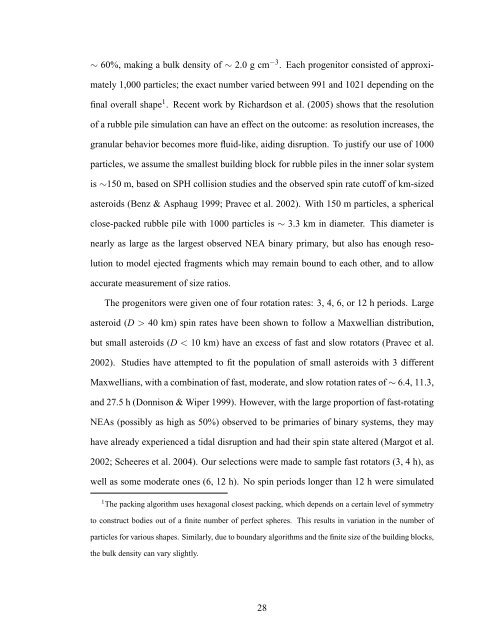Forming Binary Near-Earth Asteroids From Tidal Disruptions
Forming Binary Near-Earth Asteroids From Tidal Disruptions
Forming Binary Near-Earth Asteroids From Tidal Disruptions
Create successful ePaper yourself
Turn your PDF publications into a flip-book with our unique Google optimized e-Paper software.
∼ 60%, making a bulk density of ∼ 2.0 g cm −3 . Each progenitor consisted of approximately1,000 particles; the exact number varied between 991 and 1021 depending on thefinal overall shape 1 . Recent work by Richardson et al. (2005) shows that the resolutionof a rubble pile simulation can have an effect on the outcome: as resolution increases, thegranular behavior becomes more fluid-like, aiding disruption. To justify our use of 1000particles, we assume the smallest building block for rubble piles in the inner solar systemis ∼150 m, based on SPH collision studies and the observed spin rate cutoff of km-sizedasteroids (Benz & Asphaug 1999; Pravec et al. 2002). With 150 m particles, a sphericalclose-packed rubble pile with 1000 particles is ∼ 3.3 km in diameter. This diameter isnearly as large as the largest observed NEA binary primary, but also has enough resolutionto model ejected fragments which may remain bound to each other, and to allowaccurate measurement of size ratios.The progenitors were given one of four rotation rates: 3, 4, 6, or 12 h periods. Largeasteroid (D > 40 km) spin rates have been shown to follow a Maxwellian distribution,but small asteroids (D < 10 km) have an excess of fast and slow rotators (Pravec et al.2002). Studies have attempted to fit the population of small asteroids with 3 differentMaxwellians, with a combination of fast, moderate, and slow rotation rates of ∼ 6.4, 11.3,and 27.5 h (Donnison & Wiper 1999). However, with the large proportion of fast-rotatingNEAs (possibly as high as 50%) observed to be primaries of binary systems, they mayhave already experienced a tidal disruption and had their spin state altered (Margot et al.2002; Scheeres et al. 2004). Our selections were made to sample fast rotators (3, 4 h), aswell as some moderate ones (6, 12 h). No spin periods longer than 12 h were simulated1 The packing algorithm uses hexagonal closest packing, which depends on a certain level of symmetryto construct bodies out of a finite number of perfect spheres. This results in variation in the number ofparticles for various shapes. Similarly, due to boundary algorithms and the finite size of the building blocks,the bulk density can vary slightly.28












